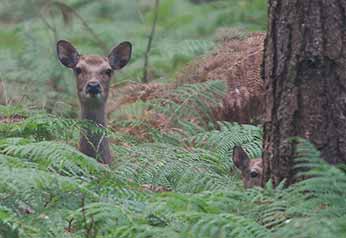New Forest deer - numbers, origins and management

New Forest deer numbers
In the New Forest, fallow deer, roe deer, red deer and sika deer are present in good numbers, whilst Reeves muntjac also occur, but, it's thought, in relatively small numbers, and are infrequently encountered.
Fallow deer are those most likely to be seen. They occur in the highest numbers - 1200 to 1400 are often present - and they are widespread throughout the area. The resident population is also often supplemented by visiting deer from nearby private land, particularly in the north of the area, in years when New Forest acorns and beech mast are abundant.
The roe deer population averages 400 - 500 animals. They, too, are fairly widespread, although many are found around the edges of the Crown Lands, close to better roe deer feeding areas on adjacent agricultural land.
Between 125 and 180 red deer are present, whilst sika deer numbers total around 100 animals. Red deer are most often seen on heathlands around Brockenhurst, although some also frequent the heaths near Burley and, occasionally, Lyndhurst. Sika deer primarily occur in a number of woodlands east of Brockenhurst, and to the south of the main railway line, although wanderers are occasionally encountered elsewhere.
Origins of New Forest deer
Both roe deer and red deer are natives, animals indigenous to the New Forest.
Roe deer, though, in much of England had been hunted to extinction by the end of the 16th century, and only reappeared in the New Forest in the late 19th century, and then as wanderers from an introduced Dorset herd.
The New Forest red deer population, too, has seen its ups and downs, and has been periodically boosted by stock introduced from elsewhere. There have also been attempted exports, too. In the 19th century, for example, The Times reported failed New Forest Stag Hunt attempts to take both red deer hinds and red deer stags alive, noting that many were wanted to stock Windsor Park, and commenting that more success would be had by the use of nets, ‘as had happened with great success 30 years ago.’
Fallow deer and sika deer are both relative newcomers to Britain and the New Forest. Circumstantial evidence suggests that fallow deer were introduced from Europe by the Normans, although it has also been less convincingly suggested that the Romans were responsible. Sika deer, we know for certain, were introduced from Asia onto the Beaulieu Estate at some time around the end of the 19th century, from where escapes and releases formed the basis for the New Forest population.
Reeves muntjac deer, meanwhile, were introduced to Woburn Park from China in the 1890s. Some were released from the park as early as 1901 but they are not thought to have become established in the wild until the 1920s and were still considered to be only locally distributed into the 1940s and 1950s. Subsequent spread was aided by further releases in a variety of locations, with individuals being first noted in areas bordering the Crown Lands of the New Forest in the late 1960s. Presence on the Crown Lands was not, though, universally accepted until at least the late 1980s.
Management of New Forest deer
New Forest deer population levels are controlled by culling, undertaken by Forestry England staff, for without this necessary evil, deer numbers would increase by an estimated 15% to 30% annually. Increased damage to trees, particularly saplings, would consequently occur and so would over-grazing by the deer with a corresponding reduction in the amount of grazing available for commoners' stock. Biodiversity, too, would be adversely affected - plant life would be reduced with knock-on effects on the availability of food for insects and birds.
(The number of deer culled in autumn and winter, 2022, was reported to be a staggering 2,035).
New Forest deer - find out lots more
References:
The History of British Mammals: Derek Yalden
Deer Watch: Richard Prior
New Forest Roe deer: John K. Fawcett
Roe deer: John K. Fawcett
Sika deer: Rory Putman
Fallow deer: Jochen Langbein and Norma Chapman
More links
Other related links
Search this site

Sadly, 58 animals were killed - 35 ponies, 13 cows, 8 donkeys and 2 sheep, whilst a further 32 were injured - 3 pigs, 9 donkeys, 11 cows and 9 ponies.
(Forty-three accidents occurred in daylight, 15 at twilight and 101 in the dark. Twenty-seven accidents were not reported by the driver involved).
Here's just one horrific example - Three donkeys killed in collision with van at notorious New Forest blackspot (Advertiser and Times)

